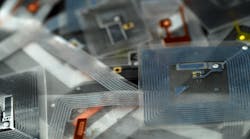Here’s what I’d like to know: Is short-range wireless really radio? Most of the wireless standards we use daily are considered short-range technologies. The question is, just what is short range? For standards like Wi-Fi, Bluetooth, Zigbee, Z-Wave, and others, it ranges from a few feet up to 100 meters or so. The range varies widely with frequency, power level, antennas, as well as many environmental conditions. These are radio technologies.
Then there are some wireless technologies that have a very short range. Short in this case meaning centimeters (cm). How can a wireless device be effective if its range is so limited? And is it really radio? Amazingly, several super-short-range standards are widely used. Take a look.
Near-Field Communications
Near-field communications (NFC) is perhaps the most popular of the several really short-range standards. It’s incorporated into most smartphones these days, and its main application is a substitute for credit cards in making payments in restaurants and other retail establishments. Its effective range is about up to about a foot or 30 cm. This standard uses the industrial-scientific-medical (ISM) frequency of 13.56 MHz. It transfers data at rates of 106, 212, 424, or 848 kb/s using ASK modulation.
It’s the name “near field” that tells the story on short-range technologies. The near field refers to the immediate area surrounding the antenna typically within one wavelength. Transmission is more by magnetic field than by combined magnetic and electric fields. The far field is considered to be the real radio signal or the electromagnetic wave that occurs at about two to ten and more wavelengths out from the antenna. The actual figure varies with the antenna type (see “What’s the Difference Between EM Near Field and Far Field?”). The near field signal is non-radiative. However, the far-field signal breaks away from the antenna or radiates.
The electric and magnetic fields support and regenerate one another along the way as Maxwell claimed. If that’s the case, can we really call the near-field signal a radio wave? NFC is really inductive coupling that occurs between transformer windings; in this case, the transmitting and receiving antennas are simply the primary and secondary windings, respectively, of an air core transformer.
Radio-Frequency Identification
Radio-frequency identification (RFID) is similar to NFC, but is realized as a passive tag rather than a powered chip radio. An RFID tag is a chip that picks up an RF signal from a reader device. Then the tag converts that signal into a dc that powers the tag circuitry. The tag then transmits its internally programmed ID code back to the reader by using what’s called backscatter ASK. Reading distance is very short, typically only a few centimeters, but it can range up to several feet with a powerful reader signal.
RFID tags are used to track shipments, label inventory items, collect tolls, enable security, and implement other asset management applications. The tags operate at frequencies of 125 kHz and 13.56 MHz and into the popular ISM 902-928 MHz band. Cheap peel-and-stick RFID tags are now used by the billions in retail, shipping, and other applications.
Hearing-Aid Wireless
A number of wireless technologies are used with modern hearing aids. Bluetooth connectivity is standard in most high-end aids today. They can connect to smartphones, auto audio hands-free systems, wireless speakers, and almost any other Bluetooth device.
An older wireless technology that’s widely used is the telecoil. This is a small coil of wire inside the hearing aid that serves as the secondary of a transformer. The primary winding is a big coil or loop of wire around a large space like a church, theater, or other venue. The sound from the audio system is applied to the loop and transmits the voice and music from microphones or other sources directly by transformer action to the hearing aids.
Another technology used in hearing aids is a 3.84-MHz radio link that transmits data via MSK (a variant of FSK) at 320 kb/s. It’s not widely used, but is now being incorporated into most new advanced aids.
Infrared Wireless
Infrared (IR) wireless has been around for decades. It’s still used for TV and audio-system remote controls that commonly operate at distances up to about 15 feet or so. A digital bit stream of codes controlling channel number, volume level, and other commands modulates an 800- to 910-nm IR LED. There are probably more IR remotes in this world than any other type of wireless device.
A specialized high-speed IR variation is the Infrared Data Association’s standard called IrDA. Maybe you remember it from the 1990s or early 2000s. It provides high-speed data transfers at rates from several megabits per second to multiple gigabits per second. Range is less than two feet or so. Note: IR is a light wave that travels only in a straight line; most IR devices have an angular range of about 15 degrees. That limits its use, but makes it very secure.
If you need a super-short-range wireless solution, these are your choices. With such a restricted distance potential, you would not think these technologies would be useful. However, the convenience of wireless and the lack of a cable make their popularity widespread.

